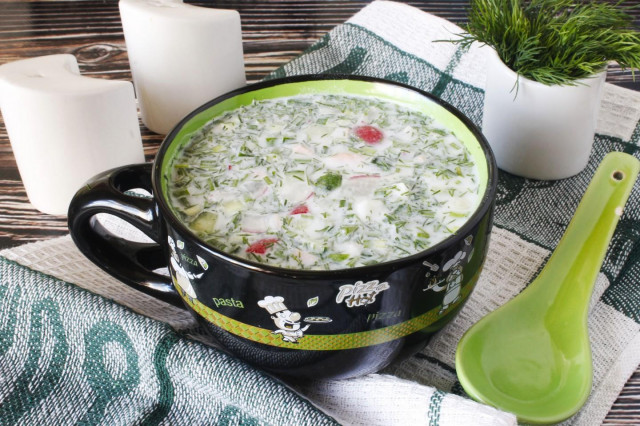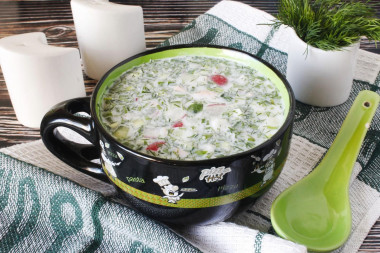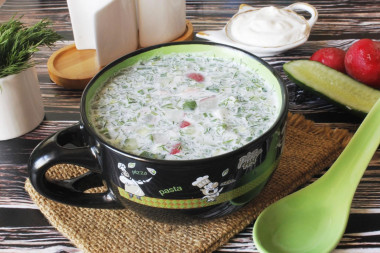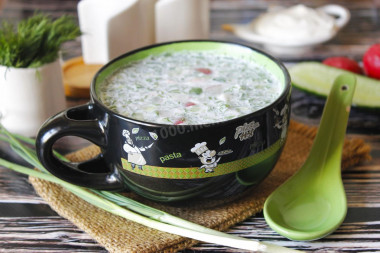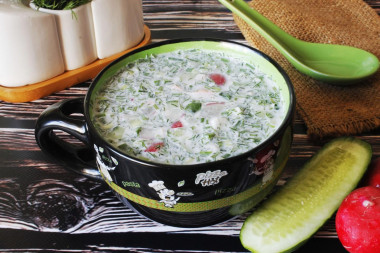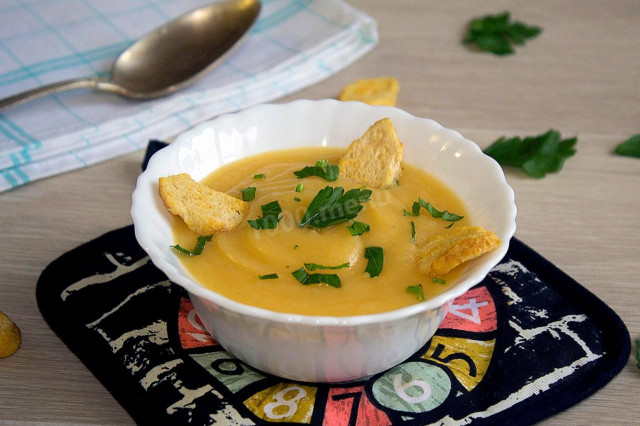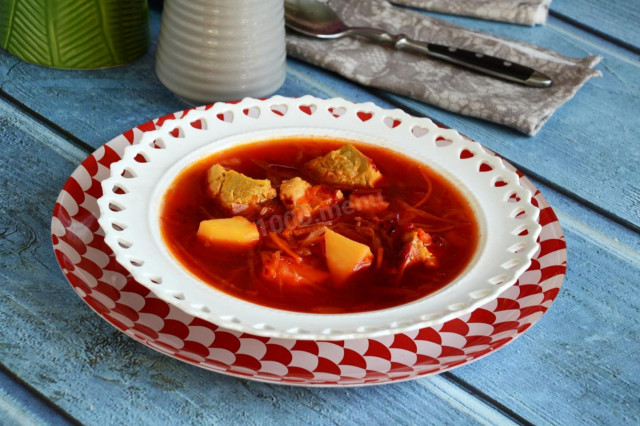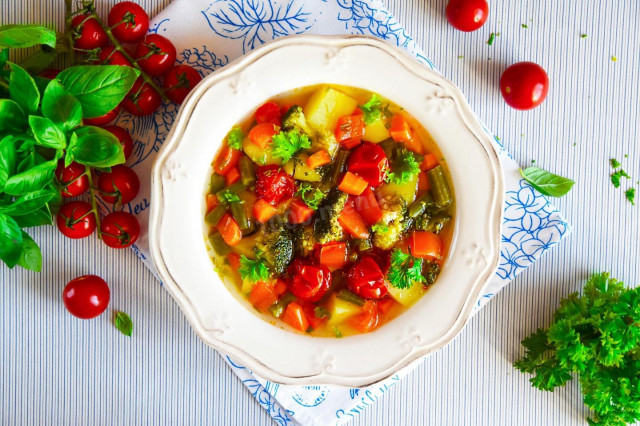Composition / ingredients
Step-by-step cooking
Step 1:
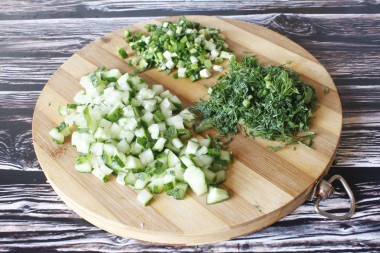
My cucumber, cut off the tips and cut into small cubes. Green onions and dill are washed and crushed. I used one ordinary small cucumber, if you have a greenhouse, then half will be enough, since they are usually long.
Step 2:
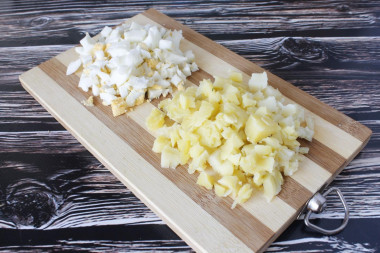
It is better to use young potatoes for okroshka, but you can also use mature ones. Thoroughly wash the tubers, cleaning them from the soil and removing the sprouts, if there are any. Put it in a saucepan with cold and salted water and boil for 25 minutes until ready. Cool, peel off the skin and eyes and cut into cubes. We put the eggs in a saucepan with potatoes at the moment when the water boils. Cook for 10 minutes, transfer to cold water. Clean and cut into small cubes too.
Step 3:
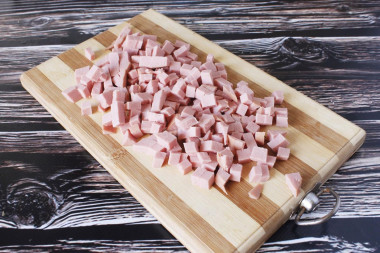
We take sausage without lard of good quality. Cut into cubes the same size as the rest of the products. How can I replace sausage? Instead of sausage, you can use boiled chicken breast or lean beef meat.
Step 4:
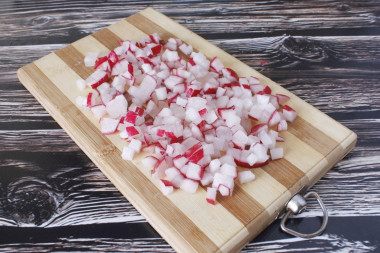
My radish and cut into cubes, also small. For this weight (100 g) I took 4 medium radishes. Instead of the usual radish, you can take daikon - this is a white subspecies of radish. How is daikon different from radish? It does not contain mustard oil and does not have a pungent smell.
Step 5:
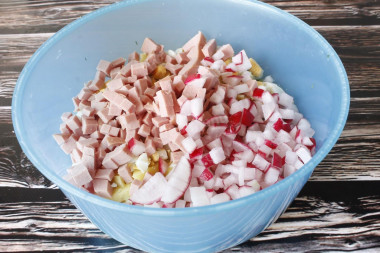
All the prepared ingredients (cucumber, greens, eggs, potatoes, sausage, radish) are transferred to a deep bowl.
Step 6:
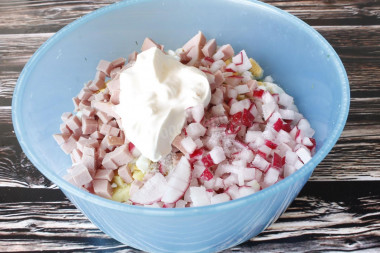
Add salt and citric acid to taste. Add sour cream. I used sour cream with a fat content of 20% and added 2 more tablespoons of mayonnaise, because I like okroshka fatter. You can take sour cream with any fat content to your liking. You can also replace it with yogurt without flavoring additives so that the dish turns out to be less caloric.
Step 7:
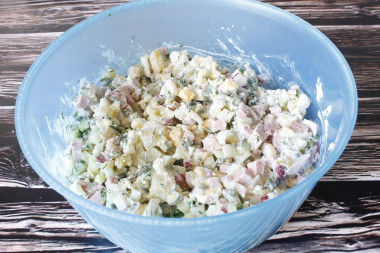
Mix everything carefully and thoroughly. If we add sour cream to the dry ingredients, it will not take lumps.
Step 8:
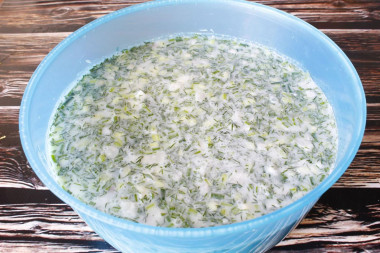
Pour in cold water, which must be boiled and cooled in advance. You can use filtered. I poured 700 milliliters of water - the okroshka turned out to be average in density. Mix everything together. Okroshka is ready. If you do not immediately eat it, then pour it into an enameled or glass container and store it in the refrigerator.
You can cook okroshka and store it in a dry form. And just before serving, add salt, citric acid, sour cream and water. That's what I usually do. But if the guests are already at the table, then dilute it immediately, adding quite a bit of salt and acid, so that later everyone can adjust the taste himself, because someone likes saltier and sourer, and someone does not. We check the readiness of potatoes with a toothpick or a knife with a sharp blade, if the tubers are easily pierced, then it is ready. Don't digest it. The final cooking time depends on the potato variety. Some varieties are not suitable because they are strongly boiled. For example, the variety "Gypsy", which is characterized by a purple color - this potato is well suited for making mashed potatoes, but not for okroshka.
Caloric content of the products possible in the composition of the dish
- Ripe potatoes - 80 kcal/100g
- Baked potatoes - 70 kcal/100g
- Mashed potatoes - 380 kcal/100g
- Boiled potatoes - 82 kcal/100g
- Potatoes in uniform - 74 kcal/100g
- Fried potatoes - 192 kcal/100g
- Fresh cucumbers - 15 kcal/100g
- Sour cream with 30% fat content - 340 kcal/100g
- Sour cream of 25% fat content - 284 kcal/100g
- Sour cream with 20 % fat content - 210 kcal/100g
- Sour cream of 10% fat content - 115 kcal/100g
- Sour cream - 210 kcal/100g
- Chicken egg - 157 kcal/100g
- Egg white - 45 kcal/100g
- Egg powder - 542 kcal/100g
- Egg yolk - 352 kcal/100g
- Ostrich egg - 118 kcal/100g
- Dill greens - 38 kcal/100g
- Radish - 20 kcal/100g
- Green onion - 19 kcal/100g
- Citric acid - 0 kcal/100g
- Salt - 0 kcal/100g
- Sausage "amateur" - 291 kcal/100g
- Sausage "Ukrainian" - 404 kcal/100g
- Diabetic sausage - 254 kcal/100g
- Sausage "doctor" - 197 kcal/100g
- Diet sausage - 170 kcal/100g
- Sausage "milk" - 252 kcal/100g
- Water - 0 kcal/100g

